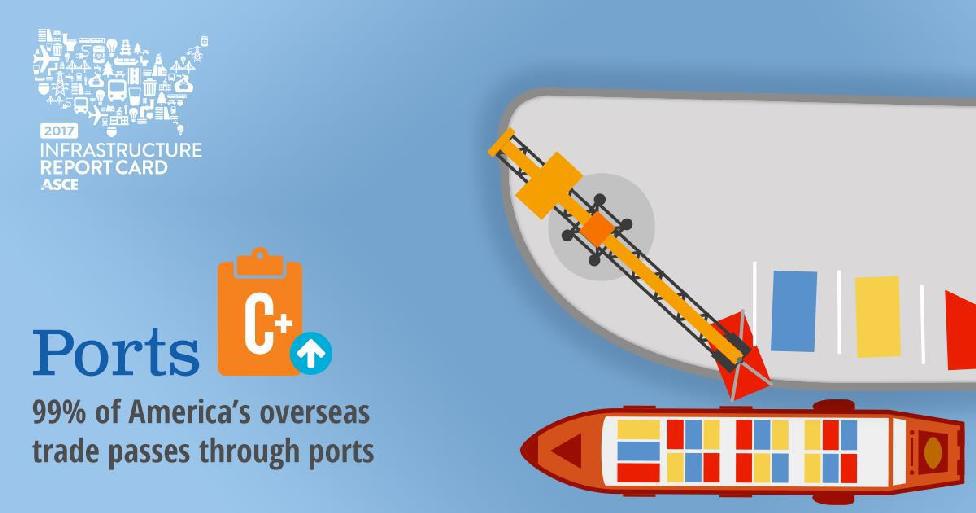News Release
FOR RELEASE - March 9, 2017
Contact: Aaron Ellis, Public Affairs Director, aellis@aapa-ports.org
(703) 684-5700
American Association of Port Authorities
Phone: (202) 792-4033
www.aapa-ports.org
 |
Commenting today on the release of the American Society of Civil Engineers’ (ASCE) 2017 Infrastructure Report Card, Kurt Nagle, president and CEO of the American Association of Port Authorities (AAPA) – the unified and recognized voice of America’s seaports – said:
“Four years ago, ASCE gave America’s marine port infrastructure a C grade, and in its latest Infrastructure Report Card, released today, ASAE gave it a C+. While this shows that progress has been made in marine port infrastructure since 2013, it also demonstrates there’s a lot left to do.
The condition of America’s port-related infrastructure, while better than it was four years ago, is still a long way from adequate.
“The rise to a C+ may be attributed to increased recognition among federal policymakers that the state of our nation’s ports, and the landside and waterway connections to them, drive our economy and stimulate jobs. ASCE’s report references the Transportation Investment Generating Economic Recovery (TIGER) competitive grant program as the primary source of federal port investment into marine ports. It also references the Fixing America’s Surface Transportation (FAST) Act of 2015, which created a national freight program with a new $4.5 billion competitive grants program.
“While a trickle of federal money has helped, the higher grade in this year’s report is also a reflection of the massive local port authority and private-sector investments into port-related infrastructure, such as rails, roads, docks, cranes and other equipment. Furthermore, many ports, cities and states have advanced payment for all or a portion of the federal responsibility to improve freight access, such as deepening their federal navigation channels to accommodate today’s modern ships.
“Among the information we shared with ASCE were the results of AAPA’s port infrastructure investment survey last year, which showed that U.S. port authorities and their private-sector partners plan to invest nearly $155 billion in capital improvements through 2020. We also conveyed our concerns about the poor condition of the water-and landside connections to many U.S. ports, making the case that while port authorities and their private-sector partners are investing heavily in their facilities, the federal government isn’t making the necessary related investments in those ports, and the road, rail and water connections to them, to help keep America’s freight moving.
“The C+ grade ASCE gave port-related infrastructure reinforces our view that the federal government is still underinvesting in the landside and waterside connections to ports. The Report Card reiterates what other national and international studies have concluded about the neglected state of our nation’s port-related transportation infrastructure, including recent reports from AAPA, as well as Business Roundtable, Building America’s Future, Eno Center for Transportation and the International Transport Forum, to name a few.
“By including seaport-related infrastructure in the ASCE's report, it reaffirms that federal investments in seaport-related infrastructure are an essential, effective utilization of limited resources, paying dividends through increased trade, economic growth, long-term job creation, and—importantly in today’s fiscal realities—over $321 billion annually in tax revenues.”
(Click here for a short clip featuring AAPA CEO Kurt Nagle discussing the importance of building America’s 21st century seaport infrastructure at a March 8, 2017 forum hosted by The Washington Post.)
About AAPA
Founded in 1912, AAPA today represents 140 of the leading seaport authorities in the United States, Canada, Latin America and the Caribbean and more than 250 sustaining and associate members, firms and individuals with an interest in seaports. According to IHS Inc. - World Trade Service, combined international sea trade moving through Western Hemisphere ports in 2015 totaled 3.45 billion metric tons in volume and US$3.36 trillion in value. Of that total, ports in Central and South America handled 1.69 billion metric tons of cargo valued at US$1.15 trillion, while North American ports handled 1.76 billion metric tons of goods, valued at US$2.21 trillion. To meet the growing demand for trade, the AAPA and its members are committed to keeping seaports navigable, secure and sustainable. For more information, visit www.aapa-ports.org. On Twitter: http://twitter.com/AAPA_Seaports